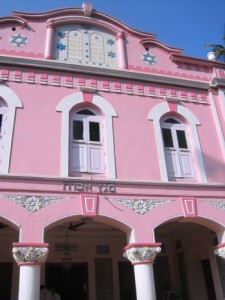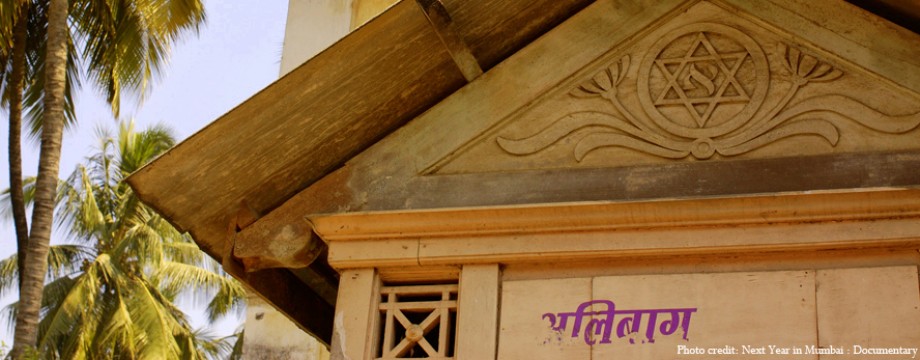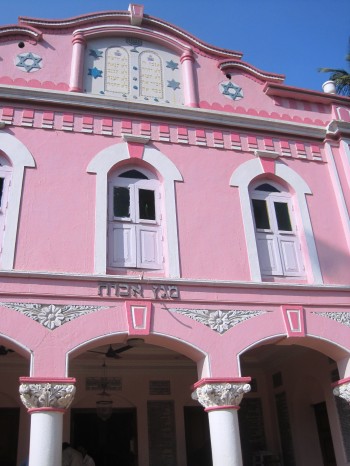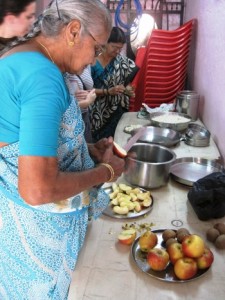Local legend says that when the first Jews of India arrived by ship on the Konkan coast of India, they were accompanied by Prophet Elijah. Escaping persecution in the Galilee, it is believed to be thanks to Elijah that the Jewish families survived a shipwreck and subsequently settled in the region. 2,100 years later, locals watch curiously as a group of nineteen Australians disembark from a large white bus and enter the nondescript gates of the oldest synagogue in the remote Panvel village in Southern India. A young man pours chai into a large silver vat by the dusty narrow street, tuk-tuk drivers wait for custom in their parked vehicles and goats wander languidly through the village.
“Jews in India? Really?” This was the common response from our social circles in Australia to any mention of an approaching journey to Mumbai to engage with its Jewish Community. Eager to unearth details of the history of Indian Jews, we young Australian professionals recently embarked on a journey to visit, understand and form relationships with the small but vibrant Indian Jewish community.
 Indian Jewry has an illustrious history which dates back over 2,000 years. There are three distinct branches of Indian Jews, each with a rich and unique heritage. The oldest and most numerous are the Bene Israelis, who are said to have escaped the destruction of the first temple in ancient Israel, traveled via a trade route and landed in the Kolkan villages. They were followed by the Kochini Jews, who escaped the Spanish Inquisition and arrived in the south in 1492. The most recent arrivals are those referred to as the Baghdadi Jews, who fled Babylon in the 1830s.An initiative of the American Jewish Joint Distribution Committee (JDC), an organisation which resonates with many as having provided assistance to survivors of the Holocaust – and for Australian Jews relocation help for their families from Europe – the trip was a whirlwind of colourful community, ancient synagogues and fascinating history. We met prominent community members, discussed pertinent issues with local Jewish youth, and took part in treasured Jewish-Indian rituals such as Khai Fest and the Eliyahu Hanavi-inspired Malida thanksgiving ceremony. We were invited into homes for Shabbat, welcomed by Jewish families and exposed to the daunting challenges faced by members on a daily basis. We were inspired by this vibrant, but fragile local community, and also by the educational programs, meals on wheels, old age homes and medical services provided by JDC.
Indian Jewry has an illustrious history which dates back over 2,000 years. There are three distinct branches of Indian Jews, each with a rich and unique heritage. The oldest and most numerous are the Bene Israelis, who are said to have escaped the destruction of the first temple in ancient Israel, traveled via a trade route and landed in the Kolkan villages. They were followed by the Kochini Jews, who escaped the Spanish Inquisition and arrived in the south in 1492. The most recent arrivals are those referred to as the Baghdadi Jews, who fled Babylon in the 1830s.An initiative of the American Jewish Joint Distribution Committee (JDC), an organisation which resonates with many as having provided assistance to survivors of the Holocaust – and for Australian Jews relocation help for their families from Europe – the trip was a whirlwind of colourful community, ancient synagogues and fascinating history. We met prominent community members, discussed pertinent issues with local Jewish youth, and took part in treasured Jewish-Indian rituals such as Khai Fest and the Eliyahu Hanavi-inspired Malida thanksgiving ceremony. We were invited into homes for Shabbat, welcomed by Jewish families and exposed to the daunting challenges faced by members on a daily basis. We were inspired by this vibrant, but fragile local community, and also by the educational programs, meals on wheels, old age homes and medical services provided by JDC.
We met George, a 72 year old man who was told by his landlord that “you are old and need to leave your home – if you die here, I will be in trouble”. In a country with no social security, limited homeless services and no safety net, JDC prevented him from being cast onto the street by swiftly providing a place for him to live in the Bayiti Old Age home. His worldly possessions were contained in a diminutive metal locker; two university certificates and a math book the lonely souvenirs of a life spanning decades.
We had previously visited meals on wheels recipients living in one-room apartments that seemed shockingly small by Western standards. Now we realised that those were luxurious in comparison to the fate that might have met those who had not ended up at the Old Age Home. Slowly, we began to appreciate a fraction of the magnitude of the challenges facing a country of over one billion people, and felt helpless at the scale of poverty and suffering. The poignant Jewish philosophy that ‘to save one life is to save a whole world’ reflects a pragmatic approach that genuinely changes the world of those fortunate enough to be assisted by the programs here.
When it is time to leave Bayiti, George clasps my hand and says that I have become a true friend. It was a rare privilege to meet individuals who have lived India’s rich and turbulent history, who remember the days of British rule, who shyly share a lifetime of stories. In a country where living can be a daily struggle, I am touched by the JDC’s mission to help those in need, people who, within a few hours, have become friends.
In Panvel village, two women in striking blue saris prepare for the traditional Malida thanksgiving ceremony, a tribute of gratitude to Eliyahu Hanavi. Five seasonal fruits are expertly chopped, rice swirled with sugar and coconut, all placed in a ceramic bowl and topped with flowers. We learn that the Beth El synagogue, which celebrated its 162nd birthday in 2010, is regarded as being of particular spiritual significance by Indian Jewry. A treasured site known for fulfillment of wishes and prayers, visitors pour in from all over the world to light a candle and make a wish. When fulfilled, the person traditionally returns to perform a Malida ceremony, a community demonstration of thanks and appreciation.
A prayer of gratitude is sung in Hebrew, followed by prayers on each piece of fruit, the rice, and the flowers. The ceremony provides us with a window into the richness of culture, tradition and history that has evolved for over 2,000 years, treasured and continued in a remote Indian village. A fusion of the warmth of Indian culture with Jewish beliefs has led to an uplifting blend of spirituality, vibrant colour and proud traditions, a timeless tapestry that embraces the local while connecting to the global.
Hearing Hebrew prayers in Indian accents, watching the same traditions as those performed at home, our group was struck by the powerful sense of connection, family and solidarity we felt with a people seemingly so foreign to us in geography, culture and lifestyle. In giving global expression to the concept that all people are responsible for one another, the work being done in this ancient community exemplifies the core of what makes me proud to be Jewish: taking responsibility for others in need, strengthening communities, and essentially – tikkun olam, healing the world.
To see the original source and author of this please go to this URL: http://ejewishphilanthropy.com/a-trip-to-india-touches-a-jewish-soul/


